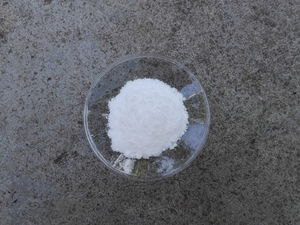Sodium perborate
 Sodium perborate hexahydrate sample
| |
| Names | |
|---|---|
| IUPAC name
Sodium perborate
| |
| Other names
Dexol
PBS-1 (mono) PBS-4 (tetra) Sodium peroxoborate Sodium peroxometaborate | |
| Properties | |
| NaBO3·nH2O | |
| Molar mass | 99.815 g/mol (monohydrate) 153.86 g/mol (tetrahydrate) |
| Appearance | White solid |
| Odor | Odorless |
| Density | 1.73 g/cm3[1] |
| Melting point | tetrahydrate 63 °C (145 °F; 336 K) |
| Boiling point | tetrahydrate 130-150 °C (266-302 °F; 403-423 K) (decomposes) |
| tetrahydrate 2.15 g/100 ml (18 °C) 2.3 g/100 ml (20 °C) | |
| Solubility | Insoluble in hydrocarbons |
| Acidity (pKa) | 10 |
| Hazards | |
| Safety data sheet | Sigma-Aldrich (monohydrate) |
| Flash point | Non-flammable |
| Lethal dose or concentration (LD, LC): | |
| LD50 (Median dose)
|
2567 mg/kg (rat, oral) |
| Related compounds | |
| Related compounds
|
Borax |
| Except where otherwise noted, data are given for materials in their standard state (at 25 °C [77 °F], 100 kPa). | |
| Infobox references | |
Sodium perborate or PBS, is a chemical compound of boron, with the chemical formula may be written NaH2BO4, Na2H4B2O8 or, more properly, [Na+]2·[B2O4(OH)4]2-.
Contents
Properties
Chemical
Sodium perborate undergoes hydrolysis in contact with water, producing hydrogen peroxide and borate.
Sodium borate added to glacial acetic acid will yield peracetic acid, which can be used to oxidize aromatic amines to nitro groups, reaction best takes place at temperatures between 50-55 °C.[2] Sodium borate in glacial acetic acid will also oxidize oximes to nitro compounds.
Physical
Sodium perborate is a white hygroscopic solid, which dissolves in water.
Availability
Conventional detergents may contain 10-20% of sodium perborate by weight, depending on the brand. Some oxygen bleach powders may contain up to 80% sodium perborate.
Pure sodium borate can be bought from chemical suppliers or online.
Preparation
Sodium perborate ban be prepared by adding concentrated hydrogen peroxide to a solution of borax and sodium hydroxide.[3]
Projects
- Make hydrogen peroxide
- Make aromatic nitro compounds
- Make sulfoxides and sulfones
Handling
Safety
Sodium perborate is irritant and should be handled with care.
In the European Union, sodium perborate, like most borates, was classified as "carcinogenic, mutagenic, or toxic for reproduction" (CMR), category 1B of Regulation (EC) 790/2009, as a result of being included in Part 3 of Annex VI of the regulation 1272/2008 on Classification, Labelling and Packaging (CLP) of substances and mixtures. As a result, their use has been automatically banned in cosmetic products in the EU, in any concentration, starting 1 December 2010.[4]
Storage
Sodium perborate is best kept in closed plastic bottles.
Disposal
Can be neutralized using a reducing agent, like sodium thiosulfate or sulfite then poured down the drain. Neutralization however, is only required for disposing very large amounts of this compound, as sodium perborate is commonly used in OTC laundry bleaches which can be safely poured down the drain directly.
References
- ↑ http://www.merckmillipore.com/RO/ro/product/Sodium-perborate-tetrahydrate,MDA_CHEM-106560
- ↑ https://www.sciencedirect.com/science/article/pii/S0040402001814848
- ↑ http://www.prepchem.com/synthesis-of-sodium-perborate/
- ↑ https://www.nature.com/articles/bdjteam201575